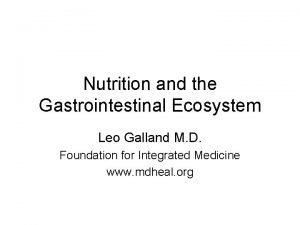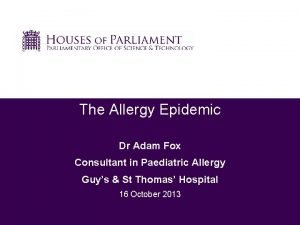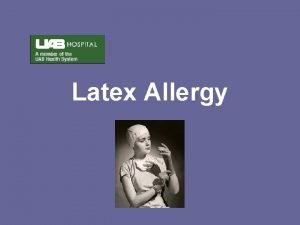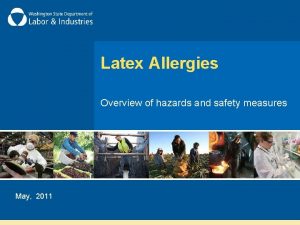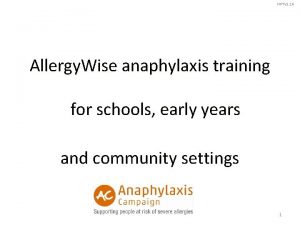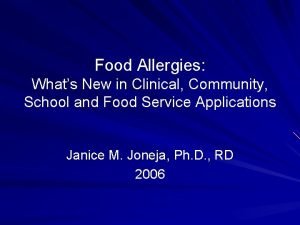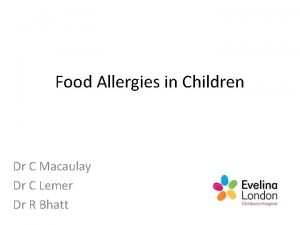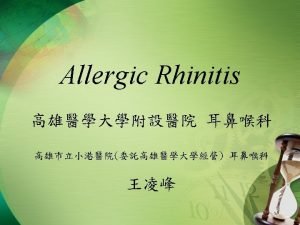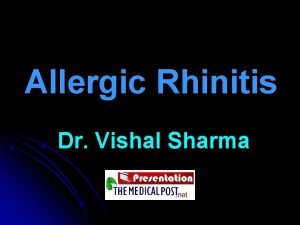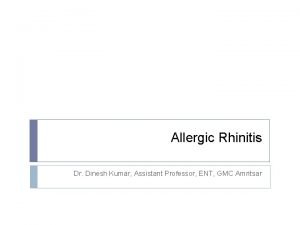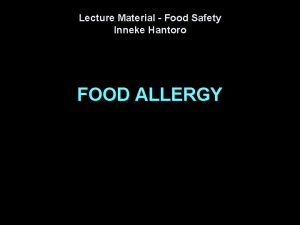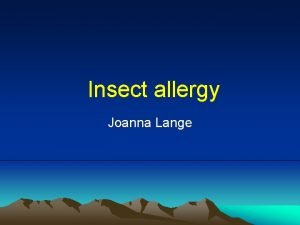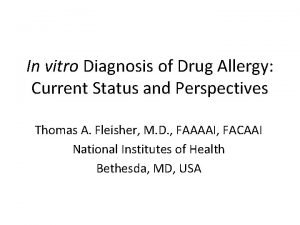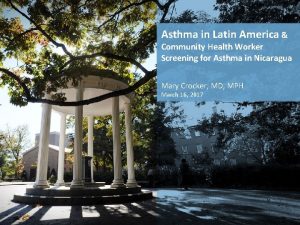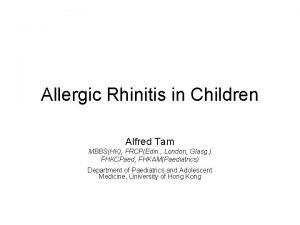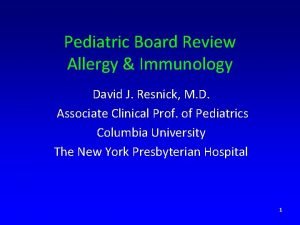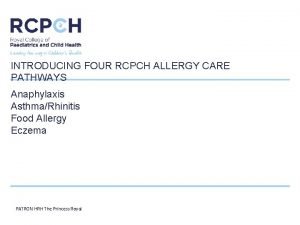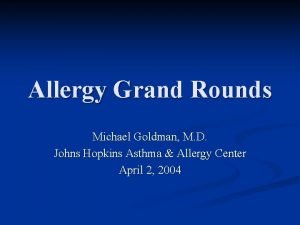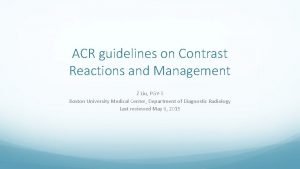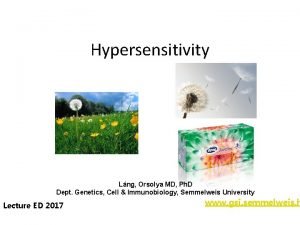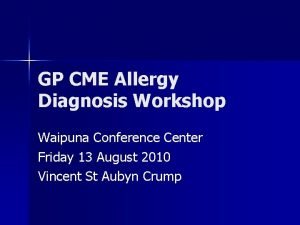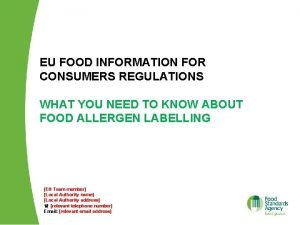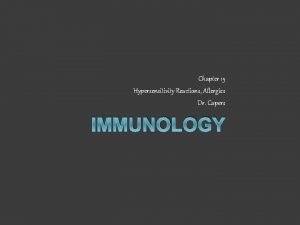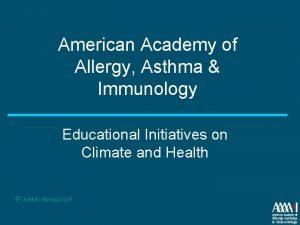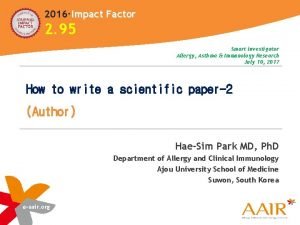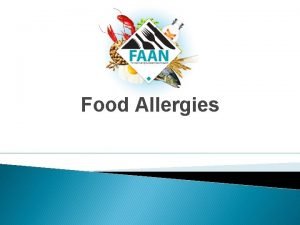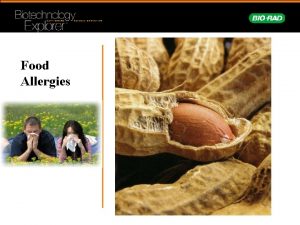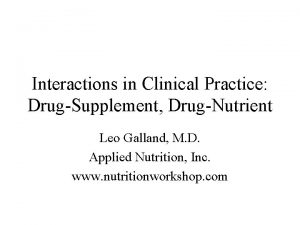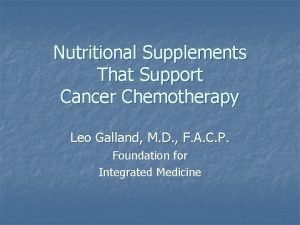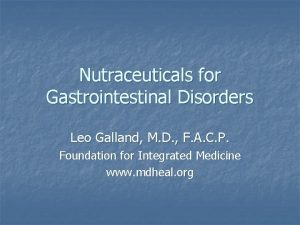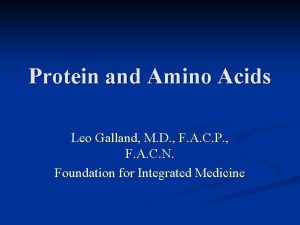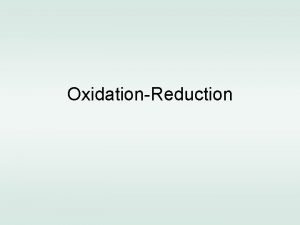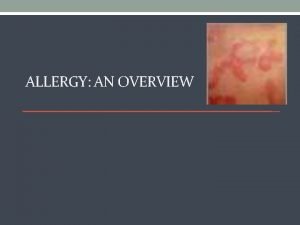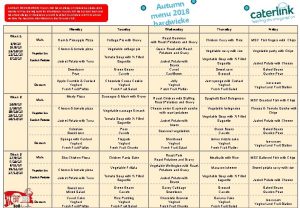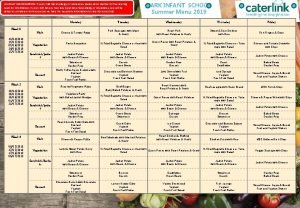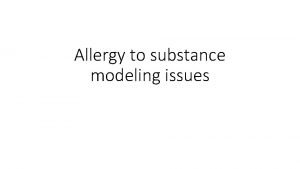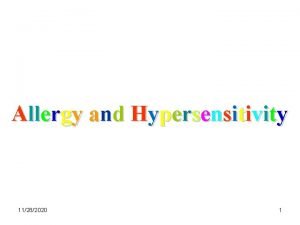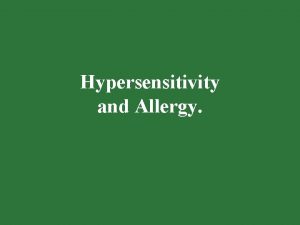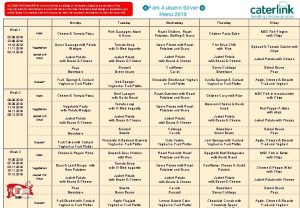Food Allergy Leo Galland M D Foundation for
























































- Slides: 56

Food Allergy Leo Galland M. D. Foundation for Integrated Medicine

HOW PREVALENT IS FOOD ALLERGY/INTOLERANCE? • 33% of 1000 teachers (56% response rate) reported avoidance specific foods because of “unpleasant” physiological reactions. • A poll of 5000 US physicians on prevalence of food allergy (14% response rate): 0 -80% (mean 10%) Foundation for Integrated Medicine

Immunologic Mechanisms of Food Intolerance • Type I (Ig. E mediated, TH 2 promoted) • Type II (Ig. G and complement mediated, cytotoxic, TH 1 promoted) • Type III (Ig. G immune complex mediated, TH 1 promoted) • Type IV (cell-mediated, TH 1 promoted) Foundation for Integrated Medicine

Non-immunologic Mechanisms of Food Intolerance • Digestive (e. g. , lactase deficiency) • Pharmacologic (e. g. , caffeine, ethanol) • Biochemical (histamine, tyramine, salicylates, sulphites, MSG) • Non-specific mast cell degranulation • Lectin-mediated glycoprotein agglutination Foundation for Integrated Medicine

Poor Sulphoxidation and Food Allergy (Scadding 1988) • 74 adults with non-Ig. E food allergy diagnosed by elimination and challenge • 78% slow carbocisteine sulfoxidizers vs 33% of controls (p<0. 005) • Carbon oxidation (debrisoquine): normal • Theory: altered metabolism of food chemicals toxic/immunogenic metabolites by novel pathways Foundation for Integrated Medicine

Foundation for Integrated Medicine

FOOD ALLERGY/INTOLERANCE: WELL-DOCUMENTED MANIFESTATIONS • Atopic Eczema • Allergic Rhinitis, Asthma • Anaphylaxis, Angioedema, Urticaria • Oral Allergy Syndrome (Ortolani) • Aphthous Ulceration • Alveolitis, Hemosiderosis • Infantile Colic • Vomiting, Diarrhea, Abdominal Pain • Irritable Bowel Syndrome • Hematochyzia, Colitis • • • Pediatric Enteropathies Celiac Disease Protein-losing Enteropathy Failure to thrive Crohn’s Disease (exacerbation) Migraine headches Migraine-associated Epilepsy ADHD Nephrotic Syndrome Allergic Arthritis Rheumatoid Arthritis (exacerbation) Foundation for Integrated Medicine

FOOD ALLERGY IN PEDIATRIC ATOPIC ECZEMA • 25 -60% are food reactive • Increased gut permeability – at baseline – after food challenges – blocked by cromolyn • Histamine release • Circulating immune complexes • Multi-system reactivity in 2/3 – 49% gastrointestinal – 23% rhinitic – 17% asthmatic • Poor correlation between food responses and prick tests, RAST: milk, egg, citrus, additives, nuts, fish, wheat, tomatoes, lamb, chicken, soy Foundation for Integrated Medicine

FOOD ALLERGY IN PERENNIAL RHINITIS (Ortolani et al) 210 patients over 1 year 3 -week oligoantigenic diet 52 improved (24. 8%) 28 Ig. E mediated (13. 3%), based upon correlation with RAST, skin testing for Integrated Medicine 24 no. Foundation correlation

FOOD ALLERGY IN RECURRENT APHTHOUS STOMATITIS • • Cytotoxic lymphocytes/antibodies Histamine release to foods (23/60) 30% correlation of HR and ulcers Gluten, milk, food additives Foundation for Integrated Medicine

FOOD ALLERGY IN HYPERKINETIC SYNDROME (Egger et al, Lancet 1985) 76 children seen on referral (60 boys, 16 girls) age 2 -15 (mean 7. 3) 37 from dysfunctional families 4 weeks’ oligoantigenic diet 2 meats, 2 starch sources, 2 fruits, 1 vegetable, calcium, multivitamin Foundation for Integrated Medicine

RESPONSE TO OLIGOANTIGENIC DIET IN HYPERKINETIC SYNDROME Total number Hyperactivity: Normal Mild Moderate Severe Conners’ score Antisocial acts Headache Seizures Abdominal pain Limb pain Eczema, rash Aphthous ulcers Atopic (prick test) Pre-diet 76 0 6 31 39 24 32 48 14 54 33 29 Foundation for Integrated 15 Medicine 30 (39%) Diet 76 21 28 19 8 12 13 9 1 8 6 9 5

Summary of Egger’s Results • Open trial: 82% of children responded favorably to the oligoantigenic diet • DBPCT: 28 participated, with rating of response by parents, a neurologist and a psychologist • DBPCT: 51 -74% of the food intolerances confirmed Foundation for Integrated Medicine

FOODS PROVOKING HYPERACTIVITY IN DOUBLE-BLIND, PLACEBO-CONTROL TRIAL % REACTIVE Additives Soy Milk Chocolate Grapes Wheat Oranges Cheese Eggs Peanuts Corn Fish Oats Melon Tomato Foundation for Integrated Medicine 79 73 64 59 50 49 45 40 39 32 29 23 23 21 20

Cognitive-Emotional Symptoms and Food Allergy (King, 1981) • DBPCT: 30 adults, 28 food extracts, sub -lingual, multiple measures, 2 judges • Symptoms associated with allergen exposure: anxiety, depression, brain fog, irritability, detachment, euphoria; pruritus, cold hands, myalgia, nasal congestion, tinnitus, fatigue, headache • Occurrence p=0. 001, Severity p=0. 002 Foundation for Integrated Medicine

FOOD ALLERGY IN PEDIATRIC MIGRAINE (Egger, 1983) 88 children, oligoantigenic diet 93% cleared by 2 weeks 90% relapsed on open challenge 40 of these, DBPC TRIAL 26 confirmed (4 reacted to placebo, 8 reacted to neither) Atopy 55%, 46% hyper, 16% seizures Milk, egg, chocolate, orange, wheat benzoate, cheese, tomato, tartrazine, rye, fish, pork, beef, corn, soy, tea Foundation for Integrated Medicine

MIGRAINE-ASSOCIATED SYMPTOMS AND FOOD INTOLERANCE 88 PATIENTS Pre-diet Diet Abdominal pain, diarrhea Hyperactivity Limb pain Rhinitis RAS Vaginal discharge Asthma Eczema 61 41 41 34 15 11 7 6 27/40 provoked by DBPC food trial 10/40 provoked by placebo also Foundation for Integrated Medicine 3/40 provoked by neither 8 5 7 15 2 1 3 3

EVIDENCE FOR ALTERED IMMUNE ACTIVATION IN RESPONSE TO FOODS IN MIGRAINE (Marteletti 1991, Acta Neurologica) • • Increased circulating immune complexes Increased activated T cells and total T cells Increased plasma IL-2 levels Effective prophylaxis with oral sodium cromoglycate Foundation for Integrated Medicine

Food Allergy in Idiopathic Nephrotic Syndrome • Basophile histamine release test + - 65% of 34 patients - 5% of 19 controls wheat, beef, milk, egg, pork • 26 patients with refractory nephrosis - 6 remitted on oligoantigenic diet Foundation for Integrated Medicine

TM, a 26 old woman with massive proteinuria, anasarca • Prior: aesthetician, applying artificial nails, developed asthma, multiple inhalant allergies, provoked by allergy immunotherapy • Severe anasarca emergency hospitalization, furosemide, steroids • Proteinuria 4 gm/day, serum albumen 1. 3 gm/L, marked hyperlipidemia, normal biopsy • Required prednisone 20 mg/day maintenance Foundation for Integrated Medicine

TM, a 26 old woman with massive proteinuria, anasarca • Initial evaluation: Cushingoid, 3+ proteinuria • Method: modified fast, supported by a ricebased, oligoantigenic food supplement, tapering down prednisone and daily examination of urine protein by dipstick • Result: clearing of proteinuria in 7 days, return of proteinuria within 24 hours of ingesting hen’s eggs • Total remission for 7 years, avoids eggs Foundation for Integrated Medicine

Food Intolerance and Rheumatoid Arthritis • 5 -46% of patients in various studies have exacerbation of symptoms provoked by specific foods, mostly wheat, milk, tomatoes, various additives, some confirmed with DBPC trials • An 18 -year open study of foods provoking pain in 100 patients found that certain spices and food additives were commonest agents Foundation for Integrated Medicine

GLUTEN INTOLERANCE IS PREVALENT AND PROTEAN • Gliadin antibodies were found in 30/53 patients with neurological disease of unknown cause (73% had abnormal small bowel biopsies) Hadjivassiliou et al, Lancet 347: 369 -371 (1996) • Ig. G and Ig. A gliadin antibodies occur in 2% of Italian school children Catassi et al, Lancet 343: 200 -203 (1994) Foundation for Integrated Medicine

Cow’s Milk Allergy and IDDM • Children with IDDM have Ig. G against a peptide fraction of bovine serum albumen that cross-react with a pancreatic beta-cell surface protein • Adults with recent-onset IDDM show excessive T-cell proliferation in response to beta-casein, compared to normal and auto-immune controls Foundation for Integrated Medicine

HOW PREVALENT IS FOOD ALLERGY/INTOLERANCE? • 33% of 1000 teachers (56% response rate) reported avoidance specific foods because of “unpleasant” physiological reactions. • A poll of 5000 US physicians on prevalence of food allergy (14% response rate): 0 -80% (mean 10%) Foundation for Integrated Medicine

Immunologic Mechanisms of Food Intolerance • Type I (Ig. E mediated, TH 2 promoted) • Type II (Ig. G and complement mediated, cytotoxic, TH 1 promoted) • Type III (Ig. G immune complex mediated, TH 1 promoted) • Type IV (cell-mediated, TH 1 promoted) Foundation for Integrated Medicine

Non-immunologic Mechanisms of Food Intolerance • Digestive (e. g. , lactase deficiency) • Pharmacologic (e. g. , caffeine, ethanol) • Biochemical (histamine, tyramine, salicylates, sulphites, MSG) • Non-specific mast cell degranulation • Lectin-mediated glycoprotein agglutination Foundation for Integrated Medicine

Poor Sulphoxidation and Food Allergy (Scadding 1988) • 74 adults with non-Ig. E food allergy diagnosed by elimination and challenge • 78% slow carbocisteine sulfoxidizers vs 33% of controls (p<0. 005) • Carbon oxidation (debrisoquine): normal • Theory: altered metabolism of food chemicals toxic/immunogenic metabolites by novel pathways Foundation for Integrated Medicine

Foundation for Integrated Medicine

FOOD ALLERGY/INTOLERANCE: WELL-DOCUMENTED MANIFESTATIONS • Atopic Eczema • Allergic Rhinitis, Asthma • Anaphylaxis, Angioedema, Urticaria • Oral Allergy Syndrome (Ortolani) • Aphthous Ulceration • Alveolitis, Hemosiderosis • Infantile Colic • Vomiting, Diarrhea, Abdominal Pain • Irritable Bowel Syndrome • Hematochyzia, Colitis • • • Pediatric Enteropathies Celiac Disease Protein-losing Enteropathy Failure to thrive Crohn’s Disease (exacerbation) Migraine headches Migraine-associated Epilepsy ADHD Nephrotic Syndrome Allergic Arthritis Rheumatoid Arthritis (exacerbation) Foundation for Integrated Medicine

FOOD ALLERGY IN PEDIATRIC ATOPIC ECZEMA • 25 -60% are food reactive • Increased gut permeability – at baseline – after food challenges – blocked by cromolyn • Histamine release • Circulating immune complexes • Multi-system reactivity in 2/3 – 49% gastrointestinal – 23% rhinitic – 17% asthmatic • Poor correlation between food responses and prick tests, RAST: milk, egg, citrus, additives, nuts, fish, wheat, tomatoes, lamb, chicken, soy Foundation for Integrated Medicine

FOOD ALLERGY IN PERENNIAL RHINITIS (Ortolani et al) 210 patients over 1 year 3 -week oligoantigenic diet 52 improved (24. 8%) 28 Ig. E mediated (13. 3%), based upon correlation with RAST, skin testing for Integrated Medicine 24 no. Foundation correlation

FOOD ALLERGY IN RECURRENT APHTHOUS STOMATITIS • • Cytotoxic lymphocytes/antibodies Histamine release to foods (23/60) 30% correlation of HR and ulcers Gluten, milk, food additives Foundation for Integrated Medicine

FOOD ALLERGY IN HYPERKINETIC SYNDROME (Egger et al, Lancet 1985) 76 children seen on referral (60 boys, 16 girls) age 2 -15 (mean 7. 3) 37 from dysfunctional families 4 weeks’ oligoantigenic diet 2 meats, 2 starch sources, 2 fruits, 1 vegetable, calcium, multivitamin Foundation for Integrated Medicine

RESPONSE TO OLIGOANTIGENIC DIET IN HYPERKINETIC SYNDROME Total number Hyperactivity: Normal Mild Moderate Severe Conners’ score Antisocial acts Headache Seizures Abdominal pain Limb pain Eczema, rash Aphthous ulcers Atopic (prick test) Pre-diet 76 0 6 31 39 24 32 48 14 54 33 29 Foundation for Integrated 15 Medicine 30 (39%) Diet 76 21 28 19 8 12 13 9 1 8 6 9 5

Summary of Egger’s Results • Open trial: 82% of children responded favorably to the oligoantigenic diet • DBPCT: 28 participated, with rating of response by parents, a neurologist and a psychologist • DBPCT: 51 -74% of the food intolerances confirmed Foundation for Integrated Medicine

FOODS PROVOKING HYPERACTIVITY IN DOUBLE-BLIND, PLACEBO-CONTROL TRIAL % REACTIVE Additives Soy Milk Chocolate Grapes Wheat Oranges Cheese Eggs Peanuts Corn Fish Oats Melon Tomato Foundation for Integrated Medicine 79 73 64 59 50 49 45 40 39 32 29 23 23 21 20

Cognitive-Emotional Symptoms and Food Allergy (King, 1981) • DBPCT: 30 adults, 28 food extracts, sub -lingual, multiple measures, 2 judges • Symptoms associated with allergen exposure: anxiety, depression, brain fog, irritability, detachment, euphoria; pruritus, cold hands, myalgia, nasal congestion, tinnitus, fatigue, headache • Occurrence p=0. 001, Severity p=0. 002 Foundation for Integrated Medicine

FOOD ALLERGY IN PEDIATRIC MIGRAINE (Egger, 1983) 88 children, oligoantigenic diet 93% cleared by 2 weeks 90% relapsed on open challenge 40 of these, DBPC TRIAL 26 confirmed (4 reacted to placebo, 8 reacted to neither) Atopy 55%, 46% hyper, 16% seizures Milk, egg, chocolate, orange, wheat benzoate, cheese, tomato, tartrazine, rye, fish, pork, beef, corn, soy, tea Foundation for Integrated Medicine

MIGRAINE-ASSOCIATED SYMPTOMS AND FOOD INTOLERANCE 88 PATIENTS Pre-diet Diet Abdominal pain, diarrhea Hyperactivity Limb pain Rhinitis RAS Vaginal discharge Asthma Eczema 61 41 41 34 15 11 7 6 27/40 provoked by DBPC food trial 10/40 provoked by placebo also Foundation for Integrated Medicine 3/40 provoked by neither 8 5 7 15 2 1 3 3

EVIDENCE FOR ALTERED IMMUNE ACTIVATION IN RESPONSE TO FOODS IN MIGRAINE (Marteletti 1991, Acta Neurologica) • • Increased circulating immune complexes Increased activated T cells and total T cells Increased plasma IL-2 levels Effective prophylaxis with oral sodium cromoglycate Foundation for Integrated Medicine

Food Allergy in Idiopathic Nephrotic Syndrome • Basophile histamine release test + - 65% of 34 patients - 5% of 19 controls wheat, beef, milk, egg, pork • 26 patients with refractory nephrosis - 6 remitted on oligoantigenic diet Foundation for Integrated Medicine

TM, a 26 old woman with massive proteinuria, anasarca • Prior: aesthetician, applying artificial nails, developed asthma, multiple inhalant allergies, provoked by allergy immunotherapy • Severe anasarca emergency hospitalization, furosemide, steroids • Proteinuria 4 gm/day, serum albumen 1. 3 gm/L, marked hyperlipidemia, normal biopsy • Required prednisone 20 mg/day maintenance Foundation for Integrated Medicine

TM, a 26 old woman with massive proteinuria, anasarca • Initial evaluation: Cushingoid, 3+ proteinuria • Method: modified fast, supported by a ricebased, oligoantigenic food supplement, tapering down prednisone and daily examination of urine protein by dipstick • Result: clearing of proteinuria in 7 days, return of proteinuria within 24 hours of ingesting hen’s eggs • Total remission for 7 years, avoids eggs Foundation for Integrated Medicine

Food Intolerance and Rheumatoid Arthritis • 5 -46% of patients in various studies have exacerbation of symptoms provoked by specific foods, mostly wheat, milk, tomatoes, various additives, some confirmed with DBPC trials • An 18 -year open study of foods provoking pain in 100 patients found that certain spices and food additives were commonest agents Foundation for Integrated Medicine

GLUTEN INTOLERANCE IS PREVALENT AND PROTEAN • Gliadin antibodies were found in 30/53 patients with neurological disease of unknown cause (73% had abnormal small bowel biopsies) Hadjivassiliou et al, Lancet 347: 369 -371 (1996) • Ig. G and Ig. A gliadin antibodies occur in 2% of Italian school children Catassi et al, Lancet 343: 200 -203 (1994) Foundation for Integrated Medicine

Cow’s Milk Allergy and IDDM • Children with IDDM have Ig. G against a peptide fraction of bovine serum albumen that cross-react with a pancreatic beta-cell surface protein • Adults with recent-onset IDDM show excessive T-cell proliferation in response to beta-casein, compared to normal and auto-immune controls Foundation for Integrated Medicine

DIAGNOSIS OF FOOD ALLERGY • History – atopic disease – multisystem complaints – fluctuations – provocations - rough skin, red ears, geographic tongue • Skin tests, Ig. E (total/food specific) • Dietary elimination/challenge – symptom change – gut permeability change Foundation for Integrated Medicine

D-XYLOSE ABSORPTION DECREASES AFTER FOOD ALLERGEN CONSUMPTION • In children with cow’s milk protein enteropathy (diarrhea, pain), 1 hour blood d-xylose was significantly higher on a milk-free diet than 4 days after starting a milk-containing diet Morin et at, Lancet i: 1102 -1104 (1979) Foundation for Integrated Medicine

Foundation for Integrated Medicine

Elimination Diets • Elemental • Oligoantigenic • Avoid commonest allergens: milk, wheat, corn, soy, eggs, citrus, nuts, fish • Gluten and/or casein-free • Yeast and mold-free • Low-salicylate Foundation for Integrated Medicine

Technique of Food Elimination • Obtain baseline measure of target symptoms or signs • Complete avoidance of all food/drink containing test components for 5 -14 days • Instruct patients/parents in foods that can or should be eaten and in monitoring of symptoms Foundation for Integrated Medicine

Food Challenge Techniques • If there is no change in target parameters, return to usual diet en bloc and observe for exacerbation • If improvement is observed, introduce foods singly, one every 1 -2 days, 2 -6 challenges for each food; delayed reactions are common • If symptoms occur, hold challenges until clear • Avoid suspected symptom provokers • Re-challenge with these after completion Foundation for Integrated Medicine

TREATMENT OF FOOD ALLERGY • • Symptomatic pharmacotherapy Dietary avoidance Pre-prandial cromolyn 800 -1600 mg/day Intestinal repair Probiotics Hyposensitization by anergy induction Counseling: nutritional, psychological Foundation for Integrated Medicine

Probiotics for Managing Food Allergy • Infants with atopic eczema and cow’s milk allergy fed hydrolyzed whey formula with or without Lactobacillus GG -Clinical improvement associated with 95% decline in fecal TNF-alpha in the Lactobacillus group, signifying reduced GI inflammation Majamaa, Isolauri, J All Clin Immunol 1997 Foundation for Integrated Medicine

Probiotics for Prevention of Food Allergy in Infants • DBPCT: Lactobaciilus GG given to high risk mothers during last 2 weeks of pregnancy and for 6 months after birth to their offspring • Atopic eczema at 2 years – Controls: 31/68 (46%) – Lactobacillus 15/64 (23%), RR=0, 51 Kalliomaki et al, Lancet 357: 1076 -79 (2001) Foundation for Integrated Medicine
 Leo galland leaky gut
Leo galland leaky gut Food allergy testing auckland
Food allergy testing auckland Pile foundation details
Pile foundation details Composition of urine slideshare
Composition of urine slideshare Unit 2 food food food
Unit 2 food food food Sequence of food chain
Sequence of food chain The allergy guy
The allergy guy Surgical prep
Surgical prep Latex allergy rash pictures
Latex allergy rash pictures ü latex
ü latex Hptv
Hptv Weights of the backpacks of first graders on a school bus
Weights of the backpacks of first graders on a school bus Oas symptoms
Oas symptoms Macaulay allergy
Macaulay allergy Aria classification of allergic rhinitis
Aria classification of allergic rhinitis Fexofenadine
Fexofenadine Allergy shiners
Allergy shiners Allergy
Allergy Anegdotal
Anegdotal Allergy
Allergy Moderate persistent asthma
Moderate persistent asthma Allergy rates
Allergy rates Rhinitis allergy
Rhinitis allergy Allergy board review course
Allergy board review course Rhinitis allergy
Rhinitis allergy Allergy
Allergy Acr contrast premedication
Acr contrast premedication Anaphylactoid
Anaphylactoid Penicillin allergy cme
Penicillin allergy cme World allergy organ j
World allergy organ j Keva allergy care
Keva allergy care Eu food information for consumers regulation
Eu food information for consumers regulation Sensitization hypersensitivity
Sensitization hypersensitivity American academy of allergy asthma and immunology 2018
American academy of allergy asthma and immunology 2018 Allergy asthma immunol res impact factor
Allergy asthma immunol res impact factor Kontinuitetshantering i praktiken
Kontinuitetshantering i praktiken Typiska novell drag
Typiska novell drag Nationell inriktning för artificiell intelligens
Nationell inriktning för artificiell intelligens Returpilarna
Returpilarna Varför kallas perioden 1918-1939 för mellankrigstiden
Varför kallas perioden 1918-1939 för mellankrigstiden En lathund för arbete med kontinuitetshantering
En lathund för arbete med kontinuitetshantering Adressändring ideell förening
Adressändring ideell förening Personlig tidbok
Personlig tidbok Sura för anatom
Sura för anatom Vad är densitet
Vad är densitet Datorkunskap för nybörjare
Datorkunskap för nybörjare Stig kerman
Stig kerman Mall för debattartikel
Mall för debattartikel Delegerande ledarstil
Delegerande ledarstil Nyckelkompetenser för livslångt lärande
Nyckelkompetenser för livslångt lärande Påbyggnader för flakfordon
Påbyggnader för flakfordon Vätsketryck formel
Vätsketryck formel Offentlig förvaltning
Offentlig förvaltning Bo bergman jag fryser om dina händer
Bo bergman jag fryser om dina händer Presentera för publik crossboss
Presentera för publik crossboss Teckenspråk minoritetsspråk argument
Teckenspråk minoritetsspråk argument Vem räknas som jude
Vem räknas som jude
